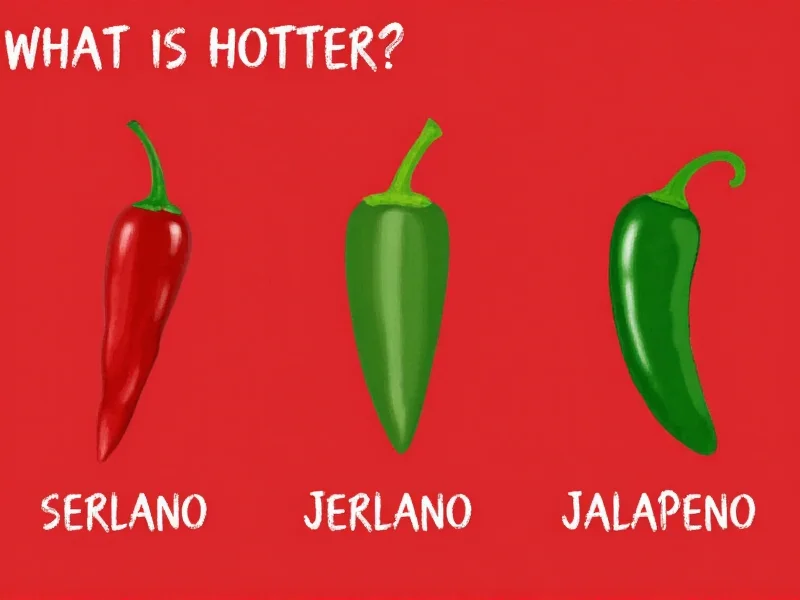When comparing what is hotter serrano or jalapeno, the answer is clear: serrano peppers deliver substantially more heat. Understanding this heat difference is crucial for home cooks, recipe developers, and spice enthusiasts who want to achieve the perfect level of spiciness in their dishes without overwhelming their palate.
Understanding the Scoville Scale Measurements
The Scoville scale, developed by pharmacist Wilbur Scoville in 1912, measures the concentration of capsaicin—the compound responsible for a chili pepper's heat. Modern testing uses high-performance liquid chromatography for more precise measurements, but the Scoville Heat Unit (SHU) remains the standard reference.
Here's how these two popular peppers compare:
| Pepper Type | Scoville Heat Units (SHU) | Relative Heat Compared to Jalapeño |
|---|---|---|
| Jalapeño | 2,500-8,000 SHU | 1x (baseline) |
| Serrano | 10,000-23,000 SHU | 1.25x-9x hotter |
Physical Characteristics and Flavor Profiles
Beyond just heat levels, serranos and jalapeños differ in appearance, flavor, and culinary applications:
- Jalapeños: Typically 2-3 inches long, smooth dark green skin that turns red when mature. They have a grassy, bright flavor with moderate heat that builds gradually.
- Serranos: Smaller (1-2.5 inches), with a bright green to red color and a more wrinkled appearance. They deliver an immediate, sharp heat with a slightly fruity, earthy flavor profile.
Practical Cooking Implications: Serrano vs Jalapeño Heat Comparison
When deciding which is hotter serrano or jalapeno for your recipe, consider these practical factors:
The heat difference significantly impacts how you should handle substitutions. If a recipe calls for jalapeños but you only have serranos, use approximately one-third the amount of serranos to achieve similar heat levels. Remember that heat concentration varies within each pepper—seeds and white membranes contain the highest capsaicin levels.
Chefs often recommend wearing gloves when handling serranos, especially when preparing large quantities. The immediate, intense heat of serranos can cause skin irritation more readily than jalapeños.
Regional Availability and Growing Conditions
Both peppers originate from Mexico but have different growing requirements:
- Jalapeños grow well in various climates and are widely available year-round in most supermarkets. They're the most commonly consumed chili pepper in the United States.
- Serranos prefer warmer temperatures and are more commonly found in specialty markets, though availability has increased as spicy food popularity grows. They're frequently used in Mexican salsas like pico de gallo and salsa verde.
Culinary Applications: When to Use Each Pepper
Understanding is serrano pepper hotter than jalapeno helps determine which to use in specific dishes:
- Jalapeños work well for:
- Stuffed peppers (like jalapeño poppers)
- Milder salsas and sauces
- Infused oils and vinegars
- Adding subtle heat to guacamole
- Serranos excel in:
- Hot sauces requiring immediate heat
- Salsas where intense pepper flavor is desired
- Dishes where you want heat to dominate other flavors
- Recipes specifically calling for higher heat levels
Heat Variability Factors
Several elements affect the actual heat you'll experience when comparing how much hotter is serrano than jalapeno:
- Growing conditions: Stressors like drought increase capsaicin production
- Ripeness: Red (mature) peppers are typically hotter than green ones
- Plant genetics: Different cultivars have varying heat levels
- Preparation method: Removing seeds and membranes reduces heat significantly
This natural variability explains why sometimes a particularly hot jalapeño might approach the lower end of a serrano's heat range, though serranos consistently average much hotter.
Substitution Guidelines for Home Cooks
When working with these peppers, follow these guidelines for successful substitutions:
- To replace jalapeños with serranos: Use 1 serrano for every 3 jalapeños
- To replace serranos with jalapeños: Use 3 jalapeños for every 1 serrano
- Always taste a small piece before adding to your dish
- Consider removing seeds and membranes to reduce heat in either pepper
- For sensitive palates, start with less than the recommended substitution ratio
Health Benefits Beyond the Heat
Both peppers offer notable health benefits thanks to capsaicin and other compounds:
- Metabolism boost and potential weight management support
- Rich in vitamins C and A
- Anti-inflammatory properties
- Potential cardiovascular benefits
- Natural pain relief properties
The higher capsaicin content in serranos means they deliver these benefits more intensely, but also require more careful handling for those with sensitive systems.











 浙公网安备
33010002000092号
浙公网安备
33010002000092号 浙B2-20120091-4
浙B2-20120091-4